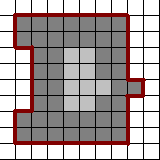A medieval city consists of square blocks, each of equal size, situated on a grid. The blocks form a connected figure with no holes. An example of such a city is shown in the picture below.

The red line shows the boundary of the city. Each block has a danger value that is assigned as follows. Blocks that have the city boundary as a side are called 0-dangerous. Blocks that are adjacent to 0-dangerous blocks and have not yet been assigned a danger value are called 1-dangerous.
Two blocks are considered adjacent if they share a side. Blocks that are adjacent to 1-dangerous blocks and have not yet been assigned a danger value are called 2-dangerous blocks, and so on. In the picture above, all 0-dangerous and 1-dangerous blocks are colored dark gray.
We can represent a city as a string of letters 'R', 'L', 'U', 'D' (right, left, up, down) describing a walk along its boundary in the clockwise or counter-clockwise direction. Each letter represents the length of a single block's side. Multiple consecutive equal letters can be written using a simple compression method. An integer K that immediately follows a letter means that the letter is repeated K times. For example, the city in the picture above can be described by the string "LUUR7D4RDLDDDL7UURU2UU". Obviously there can be multiple strings that describe the same city.
You are given a String[] boundary and an int dangerBound. Concatenate all the elements of boundary to get the string description of a city. Return the number of i-dangerous blocks in the city where i <= dangerBound.
| 